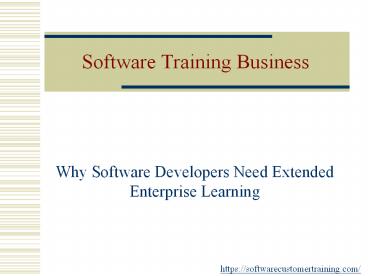Why software developers need extended enterprise learning - PowerPoint PPT Presentation
Title:
Why software developers need extended enterprise learning
Description:
It is a well-known fact that software projects are more likely to fail than hardware projects. What is less widely recognized is why software projects fail more frequently. In many respects, software and hardware projects develop in similar ways, but when it comes to implementation, the path to success is entirely different.For More information – PowerPoint PPT presentation
Number of Views:13
Title: Why software developers need extended enterprise learning
1
Software Training Business
Why Software Developers Need Extended Enterprise
Learning
https//softwarecustomertraining.com/
2
How it Works- The Software Customer Training
team has developed a unique, enterprise level
eCommerce and business learning and training
management system. It is designed so that anyone
can successfully use it without any special IT
configurations or complicated and expensive
hardware setup. We spent over 10 years perfecting
this system and have 650 companies worldwide who
we are proud to say have earned their business
month in, month out.
https//softwarecustomertraining.com/
3
The Pros, Cons and Cost of Increasing Customer
Support
https//softwarecustomertraining.com/
4
The Pros, Cons and Cost of Providing
Technicians
Back when Xerox machines were one of the most
important office technologies, Xerox came up with
an innovative plan with every machine, one would
also get a dedicated Xerox technician. The plan
worked. Xeroxs success for many decades had much
to do with the companys dedicated technicians.
Of course, while assigning technicians to pricey
pieces of hardware may be a viable business model
(in the 1960s, a single Xerox machine costs
thousands of dollars), it is simply not viable
when it comes to software applications. The
bottom line is that in the vast majority of
cases, sending technicians out to install and
troubleshoot software application problems is
simply unsustainable.
https//softwarecustomertraining.com/
5
Importance of Training
- Maintains qualified products / services
- Achieves high service standards
- Provides information for new comers
- Refreshes memory of old employees
- Achieves learning about new things technology,
products / service delivery - Reduces mistakes - minimizing costs
- Opportunity for staff to feedback / suggest
improvements - Improves communication relationships - better
teamwork
https//softwarecustomertraining.com/
6
The Pros, Cons and Cost of Extended Enterprise
Learning
- This brings us to our third option training your
customers to install, troubleshoot and maintain
the software on their own. At the level of cost,
there is no question that this is the best option
for any software company. Across sectors,
companies that invest in training their customers
report greater increases in revenue. When it
comes to software companies, the financial return
is even higher. In short, when customers report
easy implementation and maintenance of a software
application or platform, they are more likely to
continue using the application or platform over
time.
https//softwarecustomertraining.com/
7
Five Principles of Learning
- Participation involve trainees, learn by doing
- Repetition repeat ideas concepts to help
people learn - Relevance learn better when material is
meaningful and related - Transference to real world using simulations
- Feedback ask for it and adjust training
methods to audience.
https//softwarecustomertraining.com/
8
Model of the Training Process
Assessment Stage Training Stage Evaluation Stage
Organizational Needs Assessment
Task Need Assessment
Development of Training Objectives Design Select Procedures Measure Training Results
Development of Criteria for Training Evaluation Train Compare Results to Criteria
Feedback
https//softwarecustomertraining.com/
9
Nine Steps in the Training Process
- Assessing training needs
- Preparing training plan
- Specifying training objectives
- Designing the training program(s)
- Selecting the instructional methods
- Completing the training plan
- Implementing the training program
- Evaluating the training
- Planning future training
https//softwarecustomertraining.com/
10
Software Customer Training
CONTACT US
https//softwarecustomertraining.com/
Why Software Developers Need Extended Enterprise
Learning
https//softwarecustomertraining.com/


























![NOTE: To appreciate this presentation [and insure that it is not a mess], you need Microsoft fonts: PowerPoint PPT Presentation](https://s3.amazonaws.com/images.powershow.com/5420324.th0.jpg?_=20200904124)

![NOTE: To appreciate this presentation [and insure that it is not a mess], you need Microsoft fonts: PowerPoint PPT Presentation](https://s3.amazonaws.com/images.powershow.com/5430111.th0.jpg?_=20200818126)
![NOTE: To appreciate this presentation [and insure that it is not a mess], you need Microsoft fonts: PowerPoint PPT Presentation](https://s3.amazonaws.com/images.powershow.com/4925474.th0.jpg?_=20200820015)

![NOTE: To appreciate this presentation [and ensure that it is not a mess], you need Microsoft fonts: PowerPoint PPT Presentation](https://s3.amazonaws.com/images.powershow.com/5121454.th0.jpg?_=20200921114)